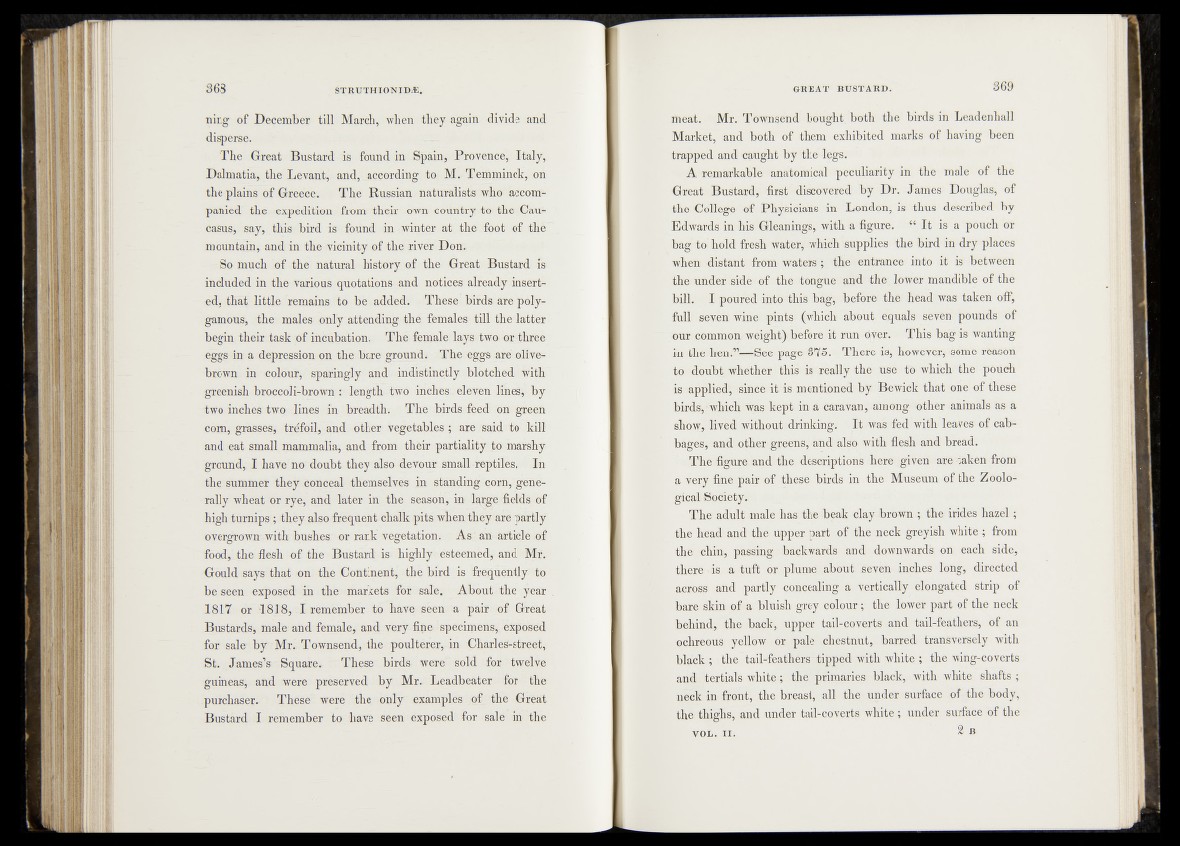
ning of December till March, when they again divide and
disperse.
The Great Bustard' is found in Spain, Provence, Italy,
Dalmatia, the Levant, and, .according to? M. Temminck, oh
the plains of Greece. The Russian naturalists who accompanied
the expedition from their own country to the Caucasus,
say, this bird is found in-winter at. the .foot of thé
mountain, and in the vicinity of the river Don*
So much of the' natural history of the Great Bustard is
included in the various quotations and notices already inserted,
that little remains to be added. These birds are polygamous,
the males only attending the females till the latter
begin their task of incubation« The female lays two or. three
eggs in a depression on the bare grounds The :eggs are olive-
brown in colour, sparingly and indistinctly blotched^ with
greenish broccoli-brown : length two iriefris^eleven KneSj- by
two inches two lines in breadth. The birds feed oü green
com, grasses, trefoil, and other vegetables; are sajkbto kill
and eat small mammalia, and from thèir partiality to marshy
ground, I have no doubt they also devour small .reptiles* In
the summer they conceal themselves in standing "corn, generally
wheat or rye, and later in the season, in lmge fields of
high turnips; they also frequent chalk pits when they are partly
overgrown .with bushes or rank vegetation. A s’ an article .of
food,„the flesh of the Bustard is- highly esteemed* and Mr.
Gould says that on the Continent, -the bird is frequently to
be seen exposed in the markets for sale.* About the- year
1817 or 1818, I remember to have seen a pair of Great
Bustards, male and-female, and very fine-1 specimens,; exposed
for sale by Mr. Townsend, the poulterer,-in CharleS-strêet,
St. James’s Square. These birds were sold dor twelve
guineas, and were preserved by Mr. Leadbeater for the
purchaser. These were the only examples of the Great
Bustard I remember to have seen exposed for -sale in the
meat. Mr. Townsend bought, both the birds in Leadenhall
Market, and both' of them exhibited marks of having been
trapped and caught by Ulm-l^gs;
Aremaikableanatomical peculiarity in the male of the
Great Bustard, first discovered -bÿ Dr. James Douglas, of
thet^ollègê of Physicians -im Londdn, is thus described by
Edwards in his G%nings, with’ a figure. " I t is a pouch or
bag- to! hold fresh water,’ which su p p lié the bird in dry places
when- distant from Watefs'^X the entrance- into if is between
the underside«of1- the ^ n ^ e ^ - n d the. lower,m-andiblè’ fif the
bill. I poured into-this bag;- before the head? was taken off,
fulh seven wine-pints f^M&M'^âboht. equals-sbvfen pounds of
our common/wiéi^hife)i¥éfdre -it run dyer. ’ This bâgbâ^ wanting
in the henÏmd&èêï phge* $7& .UdEhcrë fs? however? isbrne reason
to doubj^wheiher this. the usé to which'' the poueh
is applied; isateeli^is mentionedb^SIBewicfe-that one of-these
birds,rwhich■ was kept in a caravan, among Either animals as à
sh Ë ^ ^ ^ S k ^ ^ héutAdrmkin^^ It&was fed with leaves'* of cab-
bd^ei^and^i&er^rT^n^,^and^i|o with flèsh and biread.
* The ’figure and the description! Æere .given are taken from
^a-vérçy -fide pair of thejè| birds in the MuSeum (©»*the Zoolo-
' gicàlSoGÎety.: -
The adult male has'the beak clay brown ; the rade^hazêl ;■
the head- and^ the- Upper part of the neck greyish white ; from
the chin, p’asSing backwardsand downwards oj% each side,
there ds a tuft or plume’'about ggy%dnches long, directed
across and partly coBceàlifigÿa^ertihal^ elongated strip of
bare skin-of a bluish grey .colour ; the lower part of the neck
behind, the back, upper tail-coverts and'tail-feathers,- of an
ochreous yellow or pale chestnut, barred transversely with
black ; the taiMeathers~tipped with white ; the wing-coverts
and fertials white?; the primaries-black, with white shafts ;
neck in front, the breast, all the under surface of the body,
the thighs, and under tail-coverts white ; under surface of the
VOL. H i 2 B